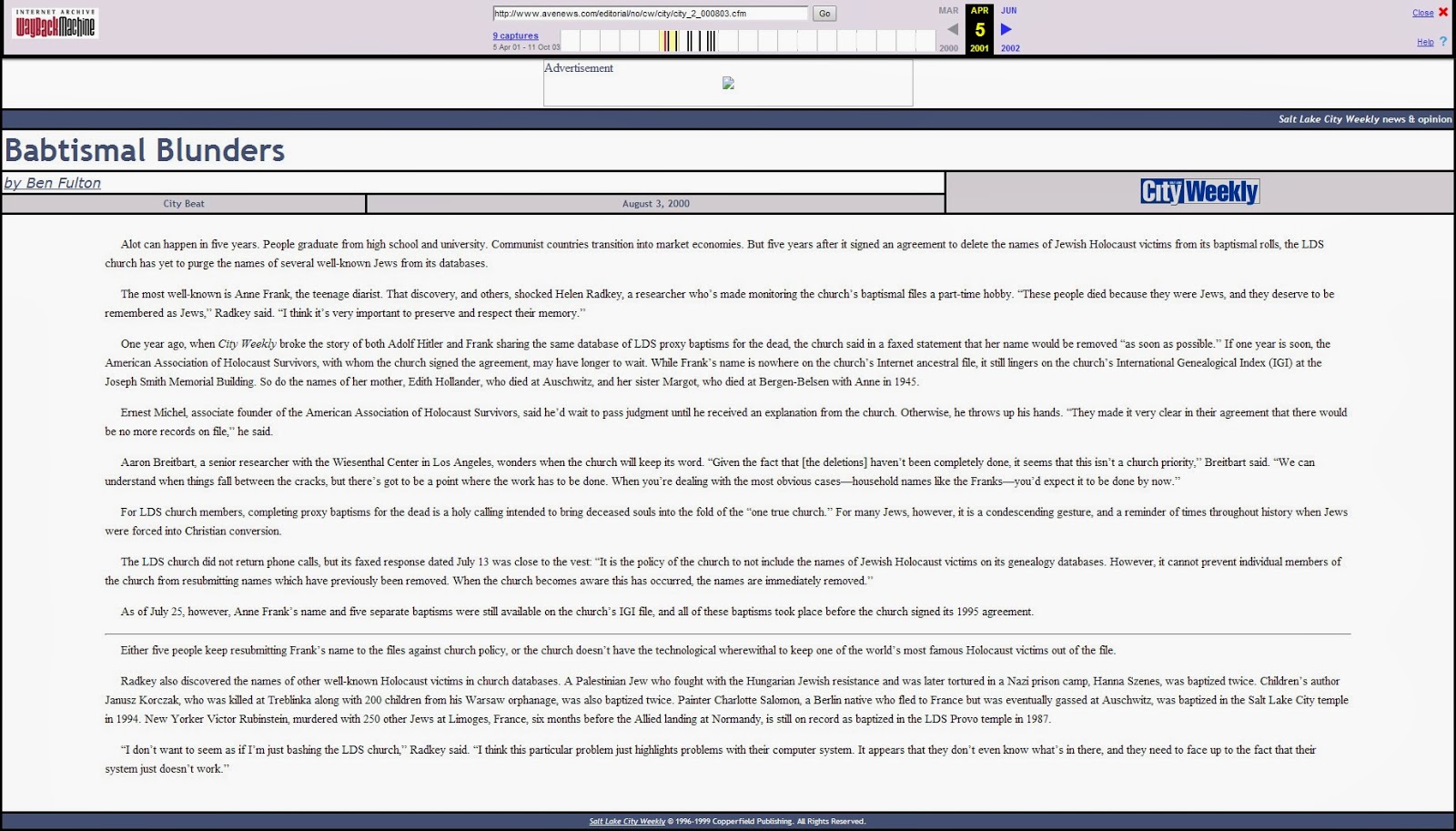Alot can happen in five years. People graduate from high school and university. Communist countries transition into market economies. But five years after it signed an agreement to delete the names of Jewish Holocaust victims from its baptismal rolls, the LDS church has yet to purge the names of several well-known Jews from its databases.
The most well-known is Anne Frank, the teenage diarist. That discovery, and others, shocked Helen Radkey, a researcher who's made monitoring the church's baptismal files a part-time hobby. "These people died because they were Jews, and they deserve to be remembered as Jews," Radkey said. "I think it's very important to preserve and respect their memory."
One year ago, when City Weekly broke the story of both Adolf Hitler and Frank sharing the same database of LDS proxy baptisms for the dead, the church said in a faxed statement that her name would be removed "as soon as possible." If one year is soon, the American Association of Holocaust Survivors, with whom the church signed the agreement, may have longer to wait. While Frank's name is nowhere on the church's Internet ancestral file, it still lingers on the church's International Genealogical Index (IGI) at the Joseph Smith Memorial Building. So do the names of her mother, Edith Hollander, who died at Auschwitz, and her sister Margot, who died at Bergen-Belsen with Anne in 1945.
Ernest Michel, associate founder of the American Association of Holocaust Survivors, said he'd wait to pass judgment until he received an explanation from the church. Otherwise, he throws up his hands. "They made it very clear in their agreement that there would be no more records on file," he said.
Aaron Breitbart, a senior researcher with the Wiesenthal Center in Los Angeles, wonders when the church will keep its word. "Given the fact that [the deletions] haven't been completely done, it seems that this isn't a church priority," Breitbart said. "We can understand when things fall between the cracks, but there's got to be a point where the work has to be done. When you're dealing with the most obvious cases—household names like the Franks—you'd expect it to be done by now."
For LDS church members, completing proxy baptisms for the dead is a holy calling intended to bring deceased souls into the fold of the "one true church." For many Jews, however, it is a condescending gesture, and a reminder of times throughout history when Jews were forced into Christian conversion.
The LDS church did not return phone calls, but its faxed response dated July 13 was close to the vest: "It is the policy of the church to not include the names of Jewish Holocaust victims on its genealogy databases. However, it cannot prevent individual members of the church from resubmitting names which have previously been removed. When the church becomes aware this has occurred, the names are immediately removed."
As of July 25, however, Anne Frank’s name and five separate baptisms were still available on the church's IGI file, and all of these baptisms took place before the church signed its 1995 agreement.
Either five people keep resubmitting Frank's name to the files against church policy, or the church doesn't have the technological wherewithal to keep one of the world's most famous Holocaust victims out of the file.
Radkey also discovered the names of other well-known Holocaust victims in church databases. A Palestinian Jew who fought with the Hungarian Jewish resistance and was later tortured in a Nazi prison camp, Hanna Szenes, was baptized twice. Children's author Janusz Korczak, who was killed at Treblinka along with 200 children from his Warsaw orphanage, was also baptized twice. Painter Charlotte Salomon, a Berlin native who fled to France but was eventually gassed at Auschwitz, was baptized in the Salt Lake City temple in 1994. New Yorker Victor Rubinstein, murdered with 250 other Jews at Limoges, France, six months before the Allied landing at Normandy, is still on record as baptized in the LDS Provo temple in 1987.
"I don't want to seem as if I'm just bashing the LDS church," Radkey said. "I think this particular problem just highlights problems with their computer system. It appears that they don't even know what's in there, and they need to face up to the fact that their system just doesn't work."

No comments:
Post a Comment